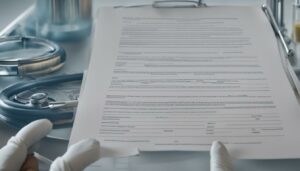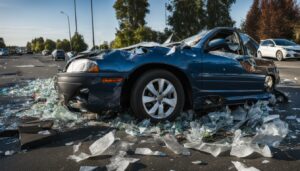Question: I was involved in a traffic accident, do I need to tell the police?
Answer: Yes, you should report a traffic accident to the police if you are involved in one, regardless of the extent of the damage or the severity of any injuries. In most states, it is a legal requirement to report an accident to the police if there is any damage to property or injury to any person, even if the damage or injury is minor.
In some states, failure to report an accident can result in fines or other penalties, and can also have an impact on any insurance claims or personal injury lawsuits that may arise from the accident.
In addition to reporting the accident to the police, it is important to exchange contact and insurance information with any other parties involved in the accident, to take photos or video of the scene and the damage, and to get the contact information of any witnesses who may have seen the accident.
Having a clear and accurate record of the accident can be critical in helping to determine who is at fault and in protecting your rights and interests if a legal dispute arises. If you are unsure of what to do after an accident, it’s a good idea to consult with a personal injury attorney who specializes in motorcycle accidents to understand your rights and options.
Question: What if the other motorcycle driver is at fault and doesn’t have insurance?
If the other driver is at fault and doesn’t have insurance (uninsured driver), you may still have options. First, check if you have uninsured/underinsured motorist coverage as part of your own motorcycle insurance policy. This coverage could help you financially in such situations. You might also consider pursuing a legal claim against the at-fault driver personally, although their ability to compensate you could be limited. Consulting an attorney experienced in motorcycle accident cases can help you explore your legal options.
Question: Can the state legally tell me that I have to wear a helmet.
Answer: Yes, the state can legally require motorcycle riders to wear helmets. The power of the state to regulate motorcycle helmets is based on the state’s police power, which allows the state to regulate activities that are deemed to be in the public interest and to promote public health, safety, and welfare.
The decision to require motorcycle riders to wear helmets is based on the recognition that helmets can help to reduce the risk of head injury and death in the event of an accident, and that the use of helmets is in the public interest.
The specific requirements for motorcycle helmets, including who is required to wear a helmet, the standards that helmets must meet, and the penalties for violating helmet laws, vary from state to state. Some states have laws that require all motorcycle riders to wear helmets, while others have laws that only require certain riders, such as minors or passengers, to wear helmets.
Question: I wasn’t wearing a helmet while I was involved in a motorcycle accident. Can I still recover damages from the other driver?
Answer: Yes, you can still recover damages from the other driver even if you were not wearing a helmet at the time of the accident. However, the fact that you were not wearing a helmet may impact the amount of damages you are able to recover.
In some states that follow a comparative negligence system, a motorcycle rider who was not wearing a helmet may be deemed to be partially at fault for their own injuries, and their recovery may be reduced by their degree of fault.
For example, if a jury determines that a motorcycle rider who was not wearing a helmet would have suffered fewer or less severe injuries if they had been wearing a helmet, the jury may assign a percentage of fault to the rider for failing to wear a helmet, and the rider’s recovery may be reduced accordingly.
Question: What does “comparative negligence” mean when determining who is liable for a traffic accident?
Answer: “Comparative negligence” is a legal doctrine that is used to determine liability in a traffic accident. It compares the degree of fault of each party involved in the accident and assigns a percentage of responsibility to each one.
In states that follow a comparative negligence system, if both parties are found to be partially at fault for the accident, the amount of damages they can recover will be reduced by their respective degree of fault.
For example, if a motorcycle rider was found to be 20% at fault for the accident and the car driver was found to be 80% at fault, the motorcycle rider could recover damages up to 80% of their total losses, while the car driver would not be entitled to any recovery.
It’s worth noting that there are several different forms of comparative negligence, including pure comparative negligence, modified comparative negligence (also known as comparative fault), and contributory negligence. The specific rules and laws that apply to comparative negligence vary depending on the jurisdiction and the specific circumstances of the accident.
Question: Will my health insurance coverage or paid sick leave from work limit my recovery for my motorcycle accident?
Answer: In most cases, your health insurance coverage or paid sick leave from work will not directly limit your recovery for a motorcycle accident. However, these resources can impact the amount of compensation you receive in a settlement or court award.
If you have health insurance, your insurance provider may seek reimbursement for the medical expenses they paid on your behalf out of any settlement or court award you receive. This is known as a subrogation claim.
Additionally, if you used paid sick leave from work as a result of your accident, the amount you received from your employer may be deducted from any settlement or court award you receive, as it may be considered a form of compensation for your losses.
It’s important to consult with a personal injury attorney who specializes in motorcycle accidents to understand the specific rules and laws that apply in your situation and to ensure that your rights are protected and that you receive a fair and just recovery for your losses.
Question: What should I do if I am involved in a motorcycle accident?
Answer: If you are involved in a motorcycle accident, it is important to take the following steps:
Seek medical attention: Your health and well-being should be your top priority, so it’s important to seek medical attention as soon as possible, even if you feel that your injuries are minor. Some injuries may not be immediately apparent and can worsen over time, so it’s better to err on the side of caution.
Call the police: Contact the police to report the accident and request that they prepare a report. This report will be important in establishing the facts and determining fault.
Gather information: Collect as much information as you can at the scene of the accident, including the names, contact information, and insurance information of all parties involved, as well as the names and contact information of any witnesses.
Take photos: If it is safe to do so, take photos of the scene of the accident, including the damage to your motorcycle and any other vehicles involved, as well as any skid marks or other physical evidence.
Contact your insurance company: Report the accident to your insurance company as soon as possible. Your insurance company may offer to send an adjuster to the scene of the accident, or you may need to provide a statement about what happened.
Consider hiring a personal injury attorney: A personal injury attorney can help you navigate the claims process, negotiate with insurance companies, and, if necessary, represent you in court.
It’s important to remember that every accident is unique, and the specific steps you should take will depend on the circumstances of your individual case. However, following these steps can help you protect your rights and ensure that you receive the compensation you deserve.
Question: How do I know if my helmet meets my state’s helmet law safety standards?
Answer: To determine if a motorcycle helmet meets your state’s helmet law safety standards, you should look for a sticker or other marking indicating that the helmet meets the standards set by the Department of Transportation (DOT) or by another recognized safety organization.
In the United States, the DOT sets minimum safety standards for motorcycle helmets, and a helmet that meets these standards will have a DOT sticker on the back of the helmet. Helmets that meet higher safety standards, such as those set by the Snell Memorial Foundation or the Economic Commission for Europe (ECE), will typically have a sticker or marking indicating the specific standard that the helmet meets.
It’s important to keep in mind that the specific helmet law requirements for your state may differ from the DOT standards, so it’s a good idea to check the specific laws and regulations in your state to ensure that your helmet meets the required standards.
Wearing a helmet that meets the safety standards of your state can help to reduce the risk of injury in the event of an accident and can be an important factor in protecting your health and well-being while riding a motorcycle.
Question: I was in a traffic accident when a car turned left in front of me while I was riding my motorcycle. Who’s fault is it?
Answer: The fault in a traffic accident involving a motorcycle and a car turning left in front of it depends on the specific circumstances of the accident. Generally speaking, the car driver may be at fault if they failed to yield the right of way to the motorcycle, or if they did not properly assess the motorcycle’s speed and proximity before making the left turn.
However, factors such as the speed of the motorcycle, road conditions, visibility, and whether or not traffic signals or signs were obeyed may also come into play in determining fault.
It’s important to note that in the United States, each state has its own laws and regulations regarding traffic accidents, so the specific rules and laws that apply in your situation may vary depending on where the accident occurred.
It is recommended to consult with a legal expert or attorney who specializes in motorcycle laws in your state to get a clearer understanding of who may be at fault in your specific situation.
How can I prove the other driver was negligent in causing the accident?
To prove negligence, you generally need to establish four key elements: a) Duty of care: Show that the other driver had a legal obligation to exercise reasonable care on the road. b) Breach of duty: Demonstrate that the other driver failed to meet that duty through their actions (e.g., reckless driving, running a red light). c) Causation: Prove that the breach of duty directly led to the accident and your injuries. d) Damages: Document your injuries, medical bills, property damage, and any other losses incurred as a result of the accident. Collecting evidence such as accident reports, eyewitness statements, photos, and expert testimony can support your claim.
Should I talk to the insurance company without a lawyer?
It’s generally advisable to consult with a lawyer before speaking extensively with the insurance company, especially the at-fault party’s insurer. Insurance adjusters may try to minimize their company’s liability and offer you a lower settlement than you deserve. An attorney can help you understand your rights, negotiate with the insurance company on your behalf, and ensure you don’t inadvertently harm your case by providing statements that could be used against you.
More reading on the subject:










